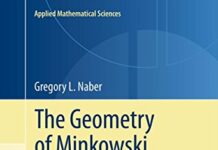
Ebook Info
- Published: 2010
- Number of pages: 454 pages
- Format: PDF
- File Size: 4.35 MB
- Authors: Gregory L. Naber
Description
Like any books on a subject as vast as this, this book has to have a point-of-view to guide the selection of topics. Naber takes the view that the rekindled interest that mathematics and physics have shown in each other of late should be fostered, and that this is best accomplished by allowing them to cohabit. The book weaves together rudimentary notions from the classical gauge theory of physics with the topological and geometrical concepts that became the mathematical models of these notions. The reader is asked to join the author on some vague notion of what an electromagnetic field might be, to be willing to accept a few of the more elementary pronouncements of quantum mechanics, and to have a solid background in real analysis and linear algebra and some of the vocabulary of modern algebra. In return, the book offers an excursion that begins with the definition of a topological space and finds its way eventually to the moduli space of anti-self-dual SU(2) connections on S4 with instanton number -1.
User’s Reviews
Reviews from Amazon users which were colected at the time this book was published on the website:
⭐I would give this text 5-stars if it didn’t have any typesetting issues. The kindle version has a number of instances where LaTeX or HTML formatting isn’t properly rendered. For example, a bold “i” showing up as “
⭐It is a wonderful book! Professor Naber’s unique style of writing which mixes perfect mathematical rigour, constructivism and intuition will definitely captivate any thirsty reader. I chose to buy the book by reading only a small section of chapter 0, which deals magnificently with Dirac’s magnetic monopole.
⭐This text is by far the best introductory text marrying basic concepts of physics with pure mathematics.Some background in the basic concepts of vector calculus, linear algebra, complex numbers and group theory is required.The author begins by motivating the mathematics by the pursuit of finding a vector potential to represent a magnetic monopole. We see that the topology of R3-0 precludes such a vector potential from existing. We see here a simple example of how the topology of a space affects the physics associated with it.The importance of the vector potential as something other than a convenient computational tool is highlighted by a reference to essential inclusion in quantum mechanics. Thus we NEED such a potential.The author now asks whether there is a “trick” or device to get around this difficulty. The device are principal bundles and connections. For example the potentials noted above must keep track of the phase of a charged test particle as it moves thru the field of a magnetic monopole. We need a “bundle” of circles ( representing the phase at each point ) over S2 ( the author explains why we need only consider S2 instead of R3-0, briefly we need only keep track of 2 of the 3 spherical co-ordinates ).Thus a curve in S2 thought of as the particles trajectory will have to be “lifted” to the bundle space by a lifting procedure called a connection.In a more general setting elementary particles have an internal structure ( spin etc ) which becomes apparent during interactions although may not be apparent in uniform motion thru a vacuum. Since the phase of the particle does not alter the modulus when calculating probabilities these do not change. However, when the particles interact phase differences are important. We need to keep track of such phases as the particles interact.Thus we need a “bundle” over a 4-manifold ( keeps track of the particles space-time path ) to keep track of such internal states. One sees we also need a group to transform states into one another ( usually incorporated into the bundle ). Connections then model physical phenomena which mediate changes in the internal states.We see that some connections satisfy the Yang-Mills equations and using the appropriate equivalence relation form Moduli spaces.Now that may seem like alot to digest with only a spattering of mathematical maturity.The beauty of the book is that the author starts from FIRST principles.Chapter 1 introduces topological concepts of topology, continuity, quotient topology, projective spaces, compactness, connectivity, covering spaces and topological groups.Chapter 2 introduces concepts of path lifting, fundamental groups, contractability, simple connectedness, covering homotopy theorem, higher homotopy groupsChapter 3 introduces principle bundles, transition functions, bundle maps and principle bundles over spheres.Chapter 4 introduces manifolds, derivatives on manifolds, tangent/cotangent spaces, submanifolds, vector fields, matrix lie groups, vector valued 1- forms, 2 forms and Riemann metricsChapter 5 gets to some physics with gauge fields and connections, curvature, Yang-Mills functional, moduli spaces, Hodge dual , matter fields and covariant derivatives.At each step the author carefully provides complete proofs and easy exercises to ensure understanding.It was a pleasure to read the book and complete the exercises. At no point did I feel frustration or boredom.
⭐Gregory Naber is to be commended for writing a thorough introduction to gauge field theory in which the mathematics is presented with clarity and rigor. For the professional mathematician who is interested in physics, or for the graduate student who prefers to see the mathematics “done right” in advanced applications to physics, Naber’s wonderful two-volume set stands apart from its major competitors, nearly all of which were written by physicists, for physicists.Despite the attention to mathematical rigor, it is clear that Naber intended his books to be accessible to a dual audience of physicists and mathematicians. For the physicists, he has included gentle introductory chapters on topological spaces, homotopy groups, principal bundles, manifolds and Lie groups, and differential forms. For mathematicians, the chapters on physical motivation, gauge fields and instantons, Yang-Mills-Higgs theory, Spinor structures, etc., provide unusually accessible introductions to some difficult physics materials.Chapter 0 of the first volume is worth the price of both books, as it leads the reader, in 26 succinct pages, to a compelling appreciation of the natural “fit” of the Hopf Bundle to the task of providing a quantum mechanical analysis of the exterior of a single magnetic monopole. For outsiders who have become incredulous about the increasingly sophisticated uses of topology and geometry in theoretical physics, this example provides some much-needed assurance. As the reader quickly learns, the use of connections on principal fiber bundles is neither gratuitous nor mathematical overkill: indeed, the bundle machinery emerges quite NATURALLY as the simplest and best mathematical tool, perfectly fitted to the special problem at hand.Any serious reader will want to buy both volumes of this set: Topology, Geometry, and Gauge Fields: Foundations (volume 1), and Topology, Geometry, and Gauge Fields: Interactions (volume 2). These books take their place alongside the work of authors such as Jerrold Marsden, Theodore Frankel, Barrett O’Neill, and Walter Thirring, all of whom write about modern mathematical physics in a way that does not obscure the true role of the mathematics.
⭐As a mathematician turned physics grad student, it is often difficult to read “Math for Physicists” books simply because of the focus on making “numbers churn out;” which, at least for me personally, more difficult to get a handle on the subject and then, in turn, use it fruitfully. This book on the other hand, is exemplary of why I got into physics in the first place. The first chapter (Physical motivations) and the last chapter (Gauge Fields and Instantons) can be read by any one with undergraduate topology under their belt and come away with a more powerful understanding of gauge theory than, in my opinion, can be found in other introductory gauge theory texts I’ve been directed to.Of course I’ll read all those said texts as well, but I’m thankful that I found this one.
Keywords
Free Download Topology, Geometry and Gauge fields: Foundations (Texts in Applied Mathematics Book 25) 2nd Edition in PDF format
Topology, Geometry and Gauge fields: Foundations (Texts in Applied Mathematics Book 25) 2nd Edition PDF Free Download
Download Topology, Geometry and Gauge fields: Foundations (Texts in Applied Mathematics Book 25) 2nd Edition 2010 PDF Free
Topology, Geometry and Gauge fields: Foundations (Texts in Applied Mathematics Book 25) 2nd Edition 2010 PDF Free Download
Download Topology, Geometry and Gauge fields: Foundations (Texts in Applied Mathematics Book 25) 2nd Edition PDF
Free Download Ebook Topology, Geometry and Gauge fields: Foundations (Texts in Applied Mathematics Book 25) 2nd Edition


